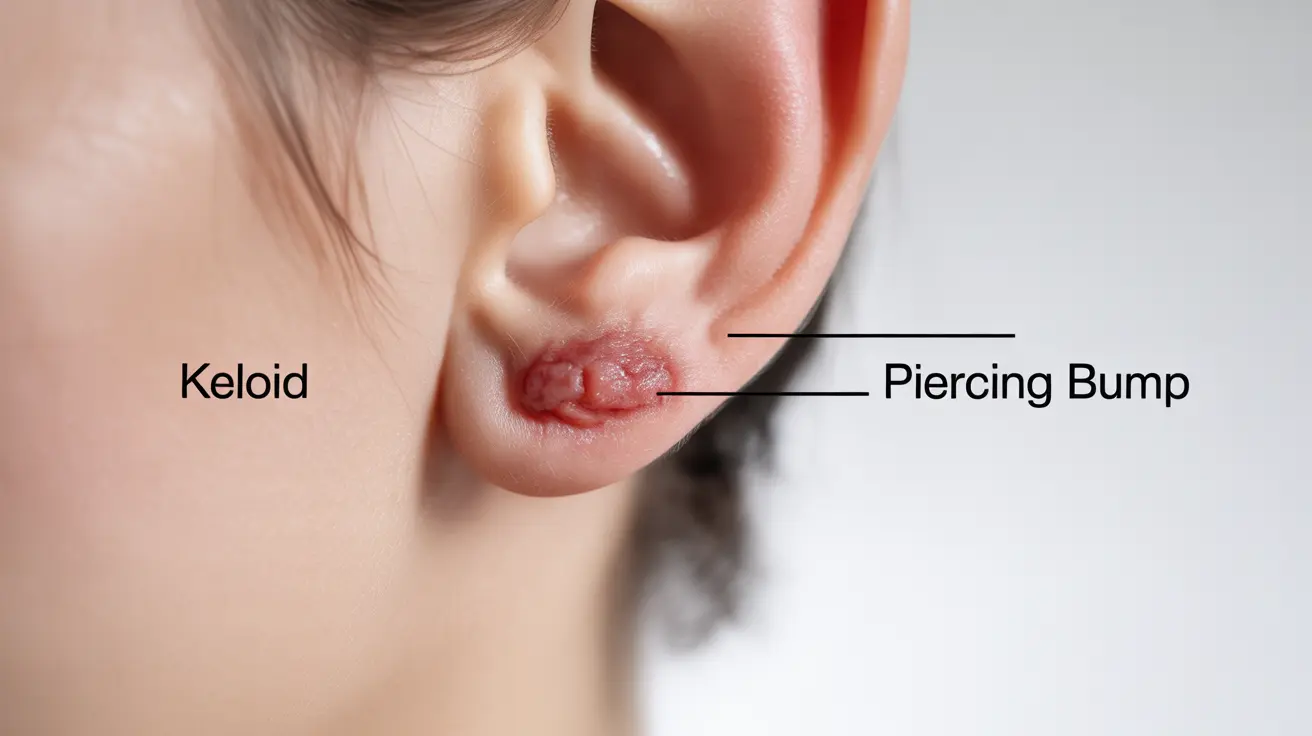Discovering a keloid forming around your new piercing can be frustrating and concerning. These raised, thick scars that extend beyond the original wound site are particularly common in certain areas like the ears, chest, and shoulders. While keloids are generally harmless, many people seek ways to reduce their appearance and prevent them from growing larger.
Understanding how to safely address keloids at home, when to try natural remedies, and when professional intervention is necessary can help you make informed decisions about your skin health. This comprehensive guide explores evidence-based home treatments and preventive measures for piercing-related keloids.
Understanding Keloids vs. Regular Piercing Bumps
Before attempting any treatment, it's crucial to distinguish between a true keloid and other common piercing complications. Keloids are permanent scar tissue formations that grow beyond the boundaries of the original wound and rarely resolve on their own. They typically appear as raised, rubbery, and often darker than the surrounding skin.
In contrast, regular piercing bumps, also called hypertrophic scars or irritation bumps, remain within the confines of the original piercing site. These bumps are usually temporary and often result from trauma, improper jewelry, or bacterial infections. They tend to be softer, redder, and more responsive to basic care adjustments.
Identifying the type of growth you're dealing with helps determine the most appropriate treatment approach and realistic expectations for improvement.
Home Remedies for Keloid Reduction
Silicone-Based Treatments
Silicone gel sheets and topical silicone gels represent some of the most scientifically supported home treatments for keloids. These products work by creating a protective barrier that maintains moisture levels and may help flatten and soften scar tissue over time.
Apply silicone gel twice daily to clean, dry skin, or wear silicone sheets for 12-24 hours as directed. Consistency is key, as results typically become noticeable after 8-12 weeks of regular use.
Natural Oil Applications
Several natural oils have shown promise in keloid management. Tea tree oil, when diluted properly (2-3 drops in a carrier oil), possesses anti-inflammatory properties that may help reduce keloid size and irritation. Similarly, rosehip seed oil and vitamin E oil can help maintain skin elasticity and potentially minimize scar tissue formation.
Always perform a patch test before using essential oils, and never apply them undiluted to the skin, especially around sensitive pierced areas.
Onion Extract and Aspirin-Based Remedies
Onion extract gels contain compounds like allicin and quercetin, which may help reduce inflammation and promote healthier scar formation. Commercial onion extract gels applied 2-3 times daily have shown modest benefits in some studies.
Aspirin paste, created by crushing aspirin tablets and mixing with water, has anti-inflammatory properties that some people find helpful. However, this remedy should be used cautiously, as aspirin can cause skin irritation in sensitive individuals.
Prevention Strategies for Piercing Keloids
Prevention remains the most effective approach for those prone to keloid formation. Choose reputable piercing studios that follow strict hygiene protocols and use high-quality, hypoallergenic jewelry materials like surgical steel, titanium, or gold.
Avoid touching or manipulating new piercings unnecessarily, and follow aftercare instructions meticulously. Keep the area clean with saline solution and avoid sleeping on fresh piercings to minimize trauma and irritation.
If you have a personal or family history of keloids, discuss this with your piercer beforehand and consider avoiding high-risk piercing locations such as the upper ear cartilage.
Timeline and Expectations for Home Treatments
Home remedies for keloids require significant patience and realistic expectations. Most natural treatments need consistent application for 3-6 months before noticeable improvements occur. Some keloids may show gradual reduction in size, thickness, or discoloration, while others may remain largely unchanged despite diligent home care.
Document your keloid's appearance with photos to track subtle changes over time. Keep in mind that complete elimination of keloids through home remedies alone is uncommon, but many people experience meaningful improvements in texture, color, and size.
When to Seek Professional Treatment
While home remedies can be helpful, certain situations warrant professional dermatological evaluation. Seek medical attention if your keloid grows rapidly, becomes painful, restricts movement, or shows signs of infection such as increased redness, warmth, or discharge.
Dermatologists offer advanced treatments including corticosteroid injections, cryotherapy, laser therapy, and surgical removal combined with preventive measures. These professional interventions often provide more dramatic results than home treatments alone.
Additionally, if home remedies haven't shown any improvement after 6 months of consistent use, consulting a healthcare provider can help you explore more effective options.
Frequently Asked Questions
What home remedies can I try to reduce the appearance of a keloid from a piercing?
Effective home remedies include silicone gel sheets or topical silicone gels applied consistently for several months. Natural oils like diluted tea tree oil, rosehip seed oil, and vitamin E oil may help soften and flatten keloids. Onion extract gels and carefully applied aspirin paste also show some promise. Always patch test new treatments and maintain realistic expectations about results.
How long does it take for home remedies like onion extract or aspirin paste to work on keloids?
Most home remedies require 3-6 months of consistent daily application before noticeable improvements occur. Onion extract gels typically need 8-12 weeks of regular use to show effects, while aspirin paste may provide some anti-inflammatory benefits within 4-8 weeks. Results vary significantly between individuals, and some keloids may respond better than others to these treatments.
Can I prevent keloids from forming after getting my ears pierced?
While you cannot guarantee prevention, several strategies significantly reduce keloid risk. Choose experienced piercers who use sterile techniques and high-quality jewelry. Follow proper aftercare with saline cleaning, avoid touching or sleeping on new piercings, and select lower-risk piercing locations when possible. If you have a family history of keloids, discuss this with your piercer and consider avoiding cartilage piercings.
What's the difference between a keloid and a regular piercing bump, and how do I treat each one?
Keloids extend beyond the original wound boundaries, are permanent, rubbery in texture, and often darker than surrounding skin. Regular piercing bumps stay within the piercing site, are temporary, softer, and usually red or flesh-colored. Treat regular bumps by improving jewelry quality, maintaining proper hygiene, and avoiding irritation. Keloids require more intensive treatments like silicone applications or professional interventions.
When should I see a dermatologist instead of trying home treatments for a keloid on my ear?
Consult a dermatologist if your keloid grows rapidly, becomes painful, restricts ear movement, or shows infection signs like increased redness or discharge. Also seek professional help if home remedies show no improvement after 6 months of consistent use, if the keloid interferes with daily activities, or if you're considering more aggressive treatments like steroid injections or laser therapy for faster results.




